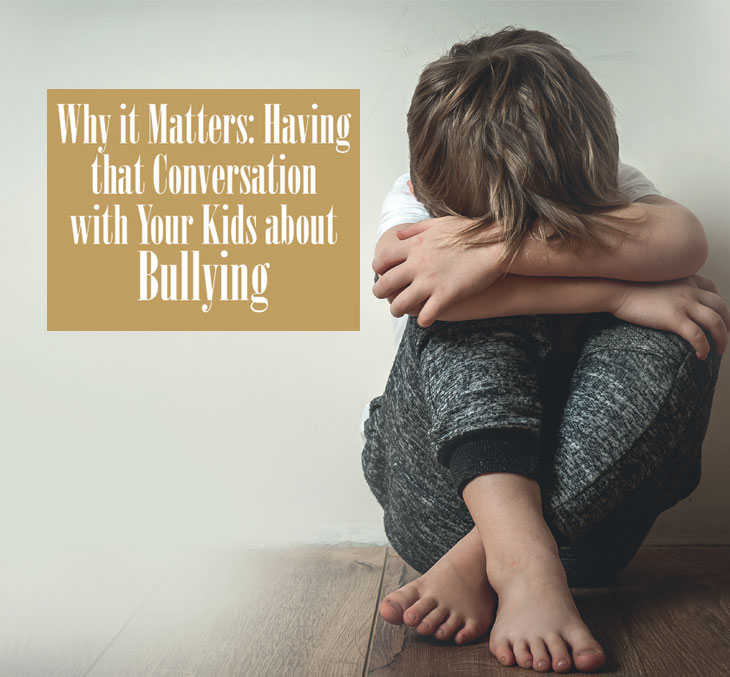 09 Jan 2019
09 Jan 2019
Why it Matters: Having that Conversation with Your Kids about Bullying
Bullying is a very serious concern gripping educational institutes around the world today. While schools adopt a zero-tolerance policy, unfortunately it still exists. Often times, the crux of the problem are the kids who keep their suffering a secret. Jyotika Aggarwal, Clinical Psychologist reveals strategies for parents to initiate that conversation with kids.
Negative Messages
At such an impressionable age, it is hard for the “bullied” to stand up for themselves. Getting the message that they are not “good enough”, children start to believe it. They are afraid of being judged as “weak” or being threatened, therefore, they don’t see the option of talking to their parents about it. To the bullied child, it feels like a lose-lose situation. Hence, it is of utmost importance to talk openly and to educate your child about it. This includes telling them about the four types of bullying: verbal—which involves teasing, writing mean messages, or name-calling, physical—which involves hitting, tripping, or breaking things, social— which could be spreading rumors and leaving someone out, and cyber bullying, which includes posting hurtful comments/pictures/videos.
The Conversation
Parents need to send the message loud and clear that bullying is unacceptable and no matter what the bully threatens, your child must never keep it a secret from you. Extinguishing bullying is as important as being able to identify it. To achieve this, it is necessary to create an empathetic and safe environment, where a child can immediately approach an adult for help. Taking assertive, quick, and organized action towards the bully sets an example to keep other bullies at bay. It also encourages bystanders and other bullied children to come forward. Parents and institutions must make it a goal to be vigilant and protect their children from this damaging experience.
THE HIDDEN SIGNS OF BULLYING PARENTS SHOULD LOOK OUT FOR
• Unexplained bruises or random complaints of body aches or illnesses so as to avoid school.
• Books being torn or things missing.
• Sudden mood swings, increased irritability, crying or the desire to “be left alone”.
• Sudden nightmares, crying while sleeping, or even bed-wetting is a red flag.
• Not wanting to go to school nor wanting to talk about school anymore.
• Changes in perception of self and ability—for example, sudden thoughts like “I’m a loser”.
• Talk of suicide or self-destructive behavior.
BY: Web Team
Magazine
COMMENTS: No Comments
 31 Dec 2018
31 Dec 2018
A Results-Driven Workout for Every Goal
When it comes to fitness, the results are unlimited. Whether you’re looking to lose weight or tone up, a clear training plan can help you achieve the results you want. Here are four different fitness goals with the recommended class to achieve the results you want.
Desired Result:
Weight Loss
Class recommendation: Cycling and Circuit Training
Cycling is a bike-based class that will maximize energy expenditure and raise your heart rate too; this coupled with a circuit training class will ensure that you are targeting muscular endurance as well as aerobic endurance.
Desired Result: Tone Up
Class recommendation: High Intensity Interval Training (HIIT) and Pilates
If your aim is to tone up then HIIT will give you an afterburn effect, helping you to continue burning calories even after you finish your workout – this alongside the weighted exercises will help tone your major muscles.
Use Pilates to tone your core – a stronger core will help develop posture and balance between the muscles you are shaping whilst attending the other recommended classes to help you tone up.
Desired Result: Increase Endurance
Class Recommendation: Swimming and Yoga
Swimming is ideal to help boost your endurance levels, plus it complements other group classes. Yoga not only works well with swimming, but on its own, can make the body more mobile and promote balance.
Desired Result: To Build Muscle
Class Recommendation: Boxing
Boxing can develop your strength and speed, but when you combine this upper body workout with a vigorous kickboxing class, it will engage the lower body. This will ensure that you are building muscle from head to toe.
(Credit: Fitness First National Academy Manager, Katherine Benson, and Fitness First Nutrition Manager, Banin Shahine)
BY: Web Team
Magazine
COMMENTS: No Comments




